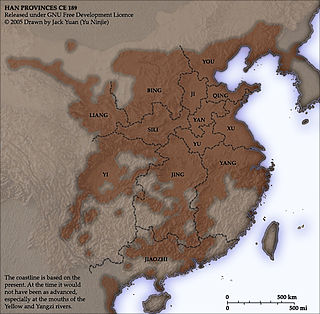The history of the administrative divisions of the Imperial China is quite complex. Across history, what is called 'China' has taken many shapes, and many political organizations. For various reasons, both the borders and names of political divisions have changed—sometimes to follow topography, sometimes to weaken former states by dividing them, and sometimes to realize a philosophical or historical ideal. For recent times, the number of recorded tiny changes is quite large; by contrast, the lack of clear, trustworthy data for ancient times forces historians and geographers to draw approximate borders for respective divisions. But thanks to imperial records and geographic descriptions, political divisions may often be redrawn with some precision. Natural changes, such as changes in a river's course, or loss of data, still make this issue difficult for ancient times.

Dazhou is a prefecture-level city in the northeast corner of Sichuan province, China, bordering Shaanxi to the north and Chongqing to the east and south.. As of 2010 census, Dazhou was home to 5,468,097 inhabitants whom 1,589,435 lived in the built-up area made of 2 urban districts.
The Jimi system or Jimifuzhou was an autonomous administrative and political organization system used in China between the 7th century and 10th century. It should not to be confused with the tributary system. The term "Jimi" was first seen in the annotation of Shiji quoted by Sima Zhen from a book of Eastern Han era, which implied to a man directing a horse or ox by the use of rein. Jimi administrative divisions were used primarily during the Tang dynasty from the 650s until the 740s. It was subsequently used in the Song, Mongol Yuan, Ming dynasties under other names such as the Tusi system until around 1726, when a new civil order under the Qing government was established.
Tingzhou fu was a prefecture in Fujian province from the Tang Dynasty (唐朝) down to the early 20th century, when it was renamed Changting (help·info).
Fuzhou is the capital city in Fujian, China.

Binzhou, formerly known as Bin County or Binxian, is a county-level city of Xianyang, Shaanxi, China, bordering Gansu province in two disparate sections to the north and west.

Tongzhou District, formerly Tongzhou City, is one of three urban districts of Nantong, Jiangsu province, China. It was a county-level city under the administration of Nantong until 2010, when it became a district of Nantong. As of 2010, Tongzhou had a population of 1,246,400.
Shuntian Prefecture was an administrative region of China during the Ming and Qing dynasties, equivalent to Beijing Municipality in today's People's Republic of China. However, the area of the prefecture jurisdiction was different. The term Shuntian fu also referred to the yamen (office) of the prefecture's local government.
Tanzhou or Tan Prefecture (潭州) was a zhou (prefecture) in imperial China centering on modern Changsha, Hunan, China. In the Yuan dynasty it was known as Tanzhou Route (潭州路) and in the Ming dynasty as Tanzhou Prefecture (潭州府). It existed (intermittently) from 589 to 1372.
Qizhou or Qi Prefecture (蘄州) was a zhou (prefecture) in imperial China centering on modern Qichun County, Hubei, China. In the Yuan dynasty and Ming dynasty it was known as Qizhou Prefecture. It existed from the 6th century until 1912.
Chenzhou or Chen Prefecture (陳州) was a zhou (prefecture) in imperial China seated in modern Huaiyang County, Henan, China. It existed (intermittently) from the 6th century to 1913.
Chenzhou or Chen Prefecture (辰州) was a zhou (prefecture) in imperial China seated in modern Yuanling County, Hunan, China. It existed (intermittently) from the 6th century to 1913.
Ningzhou or Ning Prefecture (寧州) was a zhou (prefecture) in imperial China centering on modern Ning County, Gansu, China. It existed from 554 to 1913.
Daozhou or Dao Prefecture (道州) was a zhou (prefecture) in imperial China centering on modern Dao County, Hunan, China. In the Yuan dynasty it was known as Daozhou Route (道州路) and in the Ming dynasty (briefly) as Daozhou Prefecture (道州府). It existed (intermittently) from 634 to 1913.
Fuzhou or Fu Prefecture (鄜州) was a zhou (prefecture) in imperial China, centering on modern Fu County, Shaanxi, China. It existed (intermittently) from 554 until 1913.
Binzhou or Bin Prefecture (邠州) was a zhou (prefecture) in imperial China centering around modern Bin County, Shaanxi, China. It existed from 725 to 1913.
Yangzhou or Yang Prefecture (洋州) was a zhou (prefecture) in imperial China, centering on modern Yang County, Shaanxi, China. It existed (intermittently) from the 6th century until 1370. During the short-lived Later Shu (934–965) it was known as Yuan Prefecture (源州).











